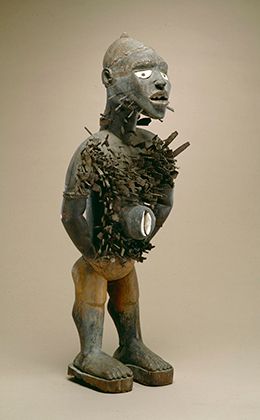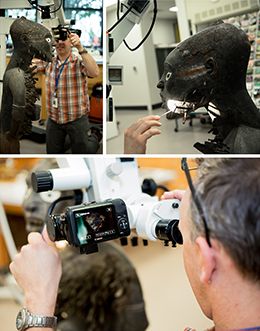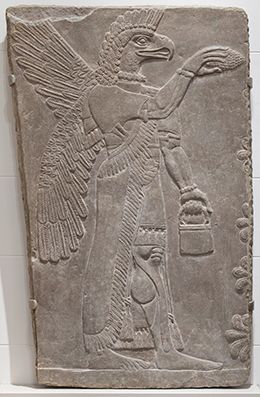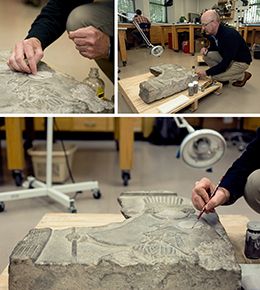|
|
 Curator's Letter Curator's Letter
Routine conservation re-evaluation and treatment of objects has long been central to art museum practice. Before an object goes on view in the DIA's permanent collection galleries, such as the new Ancient Middle East space, or goes on loan to another institution, our conservation scientists give it a thorough examination to ascertain the work's current state of wellbeing. As a lending institution, this reassures us that our piece is sufficiently healthy to withstand the rigors of transportation and climate change. At the same time, a borrower wants to know the object's present condition to be able to detect any future deterioration as well as understand its liabilities should the piece suffer accidental damage.
 |
|
Nkisi Nkonde
(Nail Figure), between 1875 and 1900, wood with screws, nails, blades, cowrie shell, and other material; unknown artist; Kongo., modern Democratic Republic of Congo. Founders Society Purchase, Eleanor Clay Ford Fund for African Art
|
 |
|
Objects Conservator and Mellon Fellow Aaron Burgess examines the DIA's Nkisi using the conservation department's new Leica surgical microscope, prior to the sculpture going to New York for the Metropolitan Museum's Kongo: Power and Majesty.
|
As one of the DIA's most celebrated icons, the
Nkisi Nkonde (
Great Nkisi), popularly known as the "nail figure," prepares for its journey to New York City as part of a major exhibition at the Metropolitan Museum of Art, it has been the focus of this scrutiny. Interestingly, one of the aims of the Met's exhibition,
Kongo: Power and Majesty, running from September 16 through January 2016, is a scientific analysis of the composition of several such figures, which today rank among the masterpieces of African art.
Among Kongo-related peoples of the Democratic Republic of Congo in Central Africa), the term
nkisi (or plural
minkisi) refers to a spiritual force that is believed to derive from close communication with spirits of the dead. This power emanates from a careful combination of special herbs, animal parts, and dirt from graveyards tied in a bundle and placed in a container, which may be a simple shell, gourd, basket, or animal horn. Or it might be inserted in the belly of a monumental figure, like the DIA's sculpture. Some ingredients are chosen for their magical powers (dog's snout or certain animal horns) and others for their healing properties (herbs), but some are included for metaphoric reasons, such as bird claws intended to catch wrongdoers. All these elements put together constitute one spiritually charged medicine. In Kongo culture, an individual who owns an nkisi is often credited with exceptional powers deriving from that person's privileged relationship with spirits of the dead. Such a person would often be an indigenous healer or diviner, called
nganga. The nganga mediates contacts with spirits and defends society against nefarious sorcery and witchcraft powers which are considered two primary sources of disease and misfortune.
In use, the nkisi blends art and performance, as the nganga manipulates its innate force with secret verbal incantations aimed at fulfilling its specific tasks: healing illnesses, protecting against negative spiritual and magical powers, and enforcing sworn oaths and agreements. At the conclusion of a typical ceremony, a nail is hammered into the sculpture to document the event. Over time, a figure would accumulate multiple nails, a testament to its active ritual history. A great nkisi or nkonde, like the DIA's, would have had many uses and been highly recognized across many communities.
Also at the Met this fall is George Caleb Bingham's The Trappers' Return, part of Navigating the West: George Caleb Bingham and the River, which runs through September 20, and John Singer Sargent's Judith Gautier, included in Sargent: Portraits of Artists and Friends, through October 4. 
Nii Quarcoopome
Co-chief Curator and Curator of African Art
Detroit Institute of Arts Back to top |
|

 New On View New On View
 |
|
| Eagle-Headed Winged Deity, 883/859 BCE, stone; unknown artist, Assyrian, modern Iraq. Gift of Mr. and Mrs. Leslie H. Green |
 |
|
| John Steele, director of conservation and objects conservator, applies a mixture of earth pigments with a brush to a 2,400-year-old Persian limestone relief from Persepolis to disguise an old surface loss. |
By the end of this month, the last mount will have been readied and the last bit of touch- up paint applied to ancient objects from modern day Iran, Iraq, Jordan, Syria, Turkey, and Yemen in preparation for the opening of a new Ancient Middle East gallery. Among the works on view are the much-loved dragon from the Ishtar Gate, a 2,400-year-old Persian limestone from a Persepolis palace, and a stone relief depicting a royal scene from the Assyrian Empire's Nimrud palace, which was recently destroyed by religious extremists. The DIA's collection of ancient Middle Eastern art includes more than 500 works spanning 8,500 years (8000 BCE to 650 CE) and includes objects from the ancient empires of Assyria, Babylonia, Persia, Rome and the Arabian Kingdom. The 177 key pieces in the new gallery illuminate the connections between ever-advancing technologies and sophisticated art forms during the rise of some of the world's earliest civilizations and empires. The Ishtar gate, a celebrated symbol of Iraqi cultural heritage, was built around 575 BCE in the city of Babylon. The gate was named in honor of the goddess Ishtar, and the DIA's glazed-tile panel features a dragon associated with Marduk, the patron god of the city. Other fine architectural pieces include a floor mosaic showing a personification of the Tigris River, a stone relief from Persepolis showing a Persian official holding a dagger, and cylinder seals of semi-precious stones with carved scenes and figures that provide a glimpse into the diverse cultures of the ancient Middle East. In light of the current crisis in the Middle East, the DIA's commitment to preserving art for current and future generations has taken on greater significance. Housed in the new gallery are two stone reliefs, one depicting a powerful Assyrian king and the other an eagle-headed winged deity (upper left) that come from a palace destroyed this year by ISIS militants. The gallery, which fills the first-floor space between CaféDIA and the photography galleries, opens to the public on Friday, October 2. Brief talks on that afternoon and on Saturday afternoon, October 3, explore the history, art, and culture of ancient cities and empires through objects now on view. Topics include art and technology in the region, Mesopotamian cylinder seals, and very ancient stories from Iraq. Top: Snake-Dragon, Symbol of Marduk, Panel from the Ishtar Gate; between 604 and 562 BCE, glazed terracotta and molded brick; unknown artist, Neo-Babylonian, modern Iraq. Founders Society Purchase, General Membership Fund Back to top |
|
 Detroit Film Theatre Detroit Film Theatre
The DFT begins its 2015 fall season Friday, September 11, but prior to that, it closes out the summer with an outdoor screening on Belle Isle of Soul Power on Thursday, September 3, 8 p.m. at the Lighthouse Grounds. The film is a 2008 documentary about the Zaire '74 music festival, featuring such performers as James Brown and B. B. King, that accompanied the "Rumble in the Jungle" heavyweight boxing match between Muhammad Ali and George Foreman. The movie is free with state park admission, which only applies to cars.
 |
|
| Conrad Anker in Meru. Courtesy of Music Box Films. Photo by Jimmy Chin. |
The fall season starts with Meru (left), a visually astonishing film of the high-stakes pursuit of big-wall climbing that captures both the nightmare and irresistible challenge for climbers attempting to scale India's Mount Meru, which towers 21,000 feet above the Ganges River. The weekend of September 18 features The Second Mother, a sharply insightful and witty Brazilian film that looks at class differences and the ultimate meaning of family through the story of a hard-working, live-in housekeeper in modern-day Sao Paulo who must reconcile with her estranged daughter while serving as a surrogate mother to her well-to-do employer's children.
The month closes out with Listen to Me Marlon (left), a documentary crafted from 200 hours of recently discovered recordings Marlon Brando made during his lifetime. The actor reveals himself as a man every bit as fascinating, surprising, and complex as any of the great characters he created on screen. The popular Animation Club returns Saturday, September 12, with the hand-drawn Zarafa, inspired by the true story of the first giraffe to visit France. The film is a stirring adventure about a small boy, Maki, determined to find a way to return Zarafa to her rightful home. DIA members, don't forget, you receive free admission to the DFT's Animation Club screenings and DFT 101 films. The Animation Club features the best in animation, both recent and classic releases, and DFT 101 presents essential classics that have redefined the language of cinema. Both series play on Saturday or Sunday afternoons. Member tickets to regular DFT shows are $7.50, a $2 savings over the general admission price. Not a member? Join here. For more DFT information, click here.
| Presented by |
 |
 |
Back to top |
|
 No Free Parking No Free Parking
Just because you don't see meters on the street, it doesn't mean you've landed on free parking. The city of Detroit has begun replacing parking meters with a new high-tech system of kiosks linked to nearby parking areas that can be activated with a smart-phone app. To get started, download the app from ParkDetroit, set up an account linked to a credit or debit card, and begin paying via your phone. There are no longer individually marked parking spaces on the streets; rather, parking is now by zone. You can move your vehicle to new spaces within the same zone without paying for more meter time. You can also extend parking time via your phone. Don't have a smart phone? Enter your license plate number into the kiosk and pay using a credit or debit card, coins, or prepaid ParkDetroit cards. According to Crain's Detroit Business, city parking officials swear Big Brother won't be watching via plate numbers entered into kiosks and that all parking enforcement cares about is ticketing for parking violations. The city's boot and tow van group, however, acting separately, will use the same hand-held readers as the parking folks to detect a plate with six or more unpaid tickets, grounds for booting a vehicle. Back to top |
|
 International Music International Music
September features music from Latin America to Africa with a stop in between. On Friday, September 4, vocalist, songwriter, and producer Sofia Rei, originally from Buenos Aires, explores connections between the various traditions of South American folklore, jazz, world music, and electronic sound. On Friday, September 18, the world, Latin jazz/salsa band PanaMO performs original compositions with strong Latin roots under the leadership of Obed Succari, a master percussionist from Panama.
 |
|
| Photo: Kristophe Diaz |
Tal National, from Niamey, the capital city of Niger, takes the stage September 11 with a fusion of musical and cultural influences that include Taureg desert blues, Malian guitar mastery, and the percussion of the Fulani. Bringing the two continents together is Donal Fox (left), on Friday, September 25. Internationally acclaimed as a composer, pianist, and improviser, Fox fuses jazz, Afro-Latin, and classical idioms into intricate new works. Taking a detour to the Middle East, Armenian-American musician Ara Topouzian demonstrates his proficiency at the kanun (a Middle Eastern harp) on Sunday, September 13. Check the DIA website for times. Back to top |
|
 News and Notes News and Notes
Ask a Curator Wednesday, September 16, is international Ask A Curator Day, a time for people to tweet questions to curators about what they do. At the DIA, Nancy Barr, co-chief curator and curator of photography, and Yao-Fen You, assistant curator of European sculpture and decorative arts, will answer questions about their profession; You from 10 a.m. to 1 p.m. and Barr from 1:30 to 4:30 p.m. Tweet your questions to @DIADetroit with the hashtag #AskACurator. Back-To-School with the DIA Shop Parents, teachers, and students of all ages will love shopping for stationery and art supplies from the DIA Shop. Art themed calendars, journals, and planners help keep families organized as daily activities ramp up during the school year. Art supplies, including kits and coloring books for adults and children, will ensure the whole family has a creative outlet. See the full assortment of back-to-school items in the store and online at diashop.org. Detroit Design Festival Three events from the Detroit Design Festival, a celebration of the city's role as a global center of design and creativity, take place at the DIA. South African artist Stephen Hobbs uses video, installation, photography, sculpture, and other media to examine the politics of urban design in cities undergoing radical physical change on Tuesday, September 22, at 6 p.m. In his lecture Anticipatory Urbanisms, on Wednesday, September 23, at 6 p.m., architect Michael Maltzan identifies issues challenging contemporary cities like Detroit, including density, polity, infrastructure, housing, commerce, and community. On Thursday, September 24, at 7 p.m., multi-instrumentalists Cicha and Bart Palyga play traditional folk instruments in Nine Languages, a project that draws on the full range of traditional music of northeast Poland while also speaking the language of contemporary music. Back to top |
|
|
| |
| Detroit Institute of Arts
5200 Woodward Avenue
Detroit, Michigan 48202
www.dia.org
313.833.7900 Comments or questions about the newsletter? Please contact us: [email protected] ADMISSION
$12.50 adults, $8 seniors (62+), $ 6 youth (6-17)
The museum is free for members and residents of Wayne, Oakland, and Macomb Counties
Contact the Membership HelpLine at
313.833.7971 or [email protected] For group sales (15 or more) contact 313.833.1292 or dia.org/grouptours
|
HOURS
Museum
Mon CLOSED
Tue, Wed 9 a.m.-4 p.m.
Thur, Fri 9 a.m.-10 p.m.
Sat, Sun 10 a.m.-5 p.m. PARKING Lighted, secure self-parking is available in the museum parking lot, between John R and Brush behind the museum, for $7. |
CaféDIA
313.833.7966
Tue, Wed, Thur 11:30 a.m.-2:30 p.m.
Fri 11 a.m.-2:30 p.m., 4-9 p.m.
Sat, Sun 11 a.m.-3 p.m. Kresge Court
Tue, Wed, Thur 9 a.m.-3:30 p.m.
Fri 9 a.m.-9:30 p.m.
Sat., Sun 10 a.m.-4:30 p.m. Museum Shop
313.833.7944 or [email protected]
Open during museum hours or online at diashop.org |
|
|
| |
|